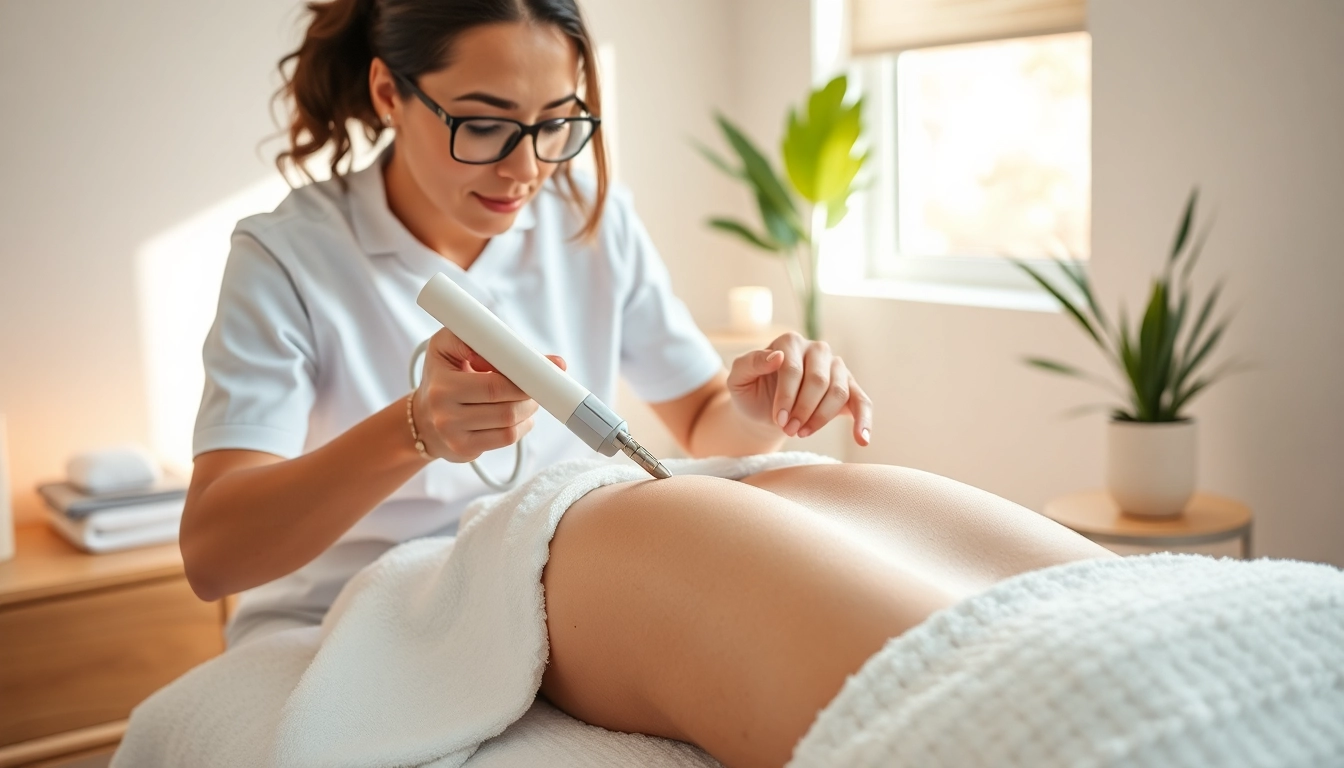Comprehensive Guide to Effective Cellulite Therapy Techniques
Understanding Cellulite and Its Causes
What is Cellulite?
Cellulite is a common cosmetic condition that affects a significant portion of the adult female population, although it can also occur in men. It is characterized by dimpled skin, particularly in areas such as the thighs, hips, abdomen, and buttocks. This uneven texture occurs when fat deposits under the skin push through connective tissue, creating a bumpy appearance. Although harmless, many individuals seek solutions due to the aesthetic concerns associated with cellulite.
Factors Contributing to Cellulite Formation
Several factors can contribute to the development of cellulite. These include genetic predisposition, hormonal changes, diet, lifestyle choices, and the natural aging process. Genetics play a crucial role in determining skin structure and fat distribution, which can make certain individuals more susceptible to cellulite. Hormonal changes, particularly fluctuations in estrogen, can also impact the structure of connective tissue, leading to increased visibility of dimpled skin.
Poor diet, particularly diets high in fat, carbohydrates, and salt, can exacerbate cellulite, as can a lack of physical activity. As people age, the natural decline in collagen production and skin elasticity can make cellulite more noticeable. Furthermore, smokers and those who fail to stay hydrated or maintain a healthy weight are often at higher risk of developing this condition.
Myths vs. Facts about Cellulite
Despite its prevalence, many misconceptions about cellulite exist. One widespread myth is that obesity is the primary cause of cellulite. While excess body fat can worsen the appearance of cellulite, it can occur in individuals at any weight. Another myth suggests that cellulite is a sign of poor health, yet it can affect otherwise healthy individuals.
Some believe that special creams can completely eliminate cellulite, but while topical treatments can temporarily plump the skin and improve its texture, they typically do not provide lasting results. Understanding these myths can help individuals develop realistic expectations when considering cellulite therapy.
Popular Methods of Cellulite Therapy
Non-Invasive Techniques for Cellulite Reduction
Non-invasive methods of cellulite therapy include options like acoustic wave therapy, radiofrequency treatment, and laser therapy. Acoustic wave therapy utilizes sound waves to break down fat cells and enhance circulation, potentially improving the appearance of cellulite. This method involves minimal discomfort and downtime, making it an appealing choice for many individuals.
Radiofrequency treatments, on the other hand, use radio waves to heat the skin and stimulate collagen production. This can lead to tighter skin and a reduction in the appearance of dimpled areas. Meanwhile, laser therapy targets the fibrous bands beneath the skin to disrupt the cellulite structure, leading to a smoother appearance.
Most of these techniques offer gradual results, requiring multiple sessions for optimal outcomes. Patients are encouraged to combine these treatments with healthy lifestyle choices, such as exercise and a balanced diet, for enhanced effectiveness.
Minimally Invasive Procedures Explained
For those seeking more immediate results, minimally invasive procedures may be appropriate. One of the most recognized methods is Cellfina, which involves a small needle that releases the fibrous connective tissue responsible for pulling down the skin and creating a dimpled appearance. This treatment is effective and can provide results lasting several years.
Another option is liposuction techniques designed specifically for cellulite, such as the use of laser-assisted lipolysis. This procedure not only removes excess fat but may also improve the structure beneath the skin, offering a dual benefit. However, these procedures typically require a recovery period and may carry more risks than non-invasive options.
At-Home Remedies and Their Effectiveness
Many individuals turn to at-home remedies in an attempt to manage and reduce the appearance of cellulite. These can include dry brushing, massage, topical creams, and dietary changes. While dry brushing can improve circulation and may temporarily enhance skin texture, the long-term effectiveness is often debated among experts.
Massage techniques can also promote lymphatic drainage and improve localized circulation, potentially reducing the visibility of cellulite over time. Similarly, certain moisturizers and creams that contain retinol or caffeine may help but should be viewed as supplementary to other treatments rather than standalone solutions.
Dietary changes that emphasize whole foods, lean proteins, fruits, and vegetables can also support overall skin health and may play a role in managing cellulite. Keeping hydrated is vital, as dehydrated skin may appear more dimpled than well-hydrated skin.
Choosing the Right Cellulite Therapy for You
Evaluating Your Skin Type and Condition
Choosing the right cellulite therapy begins with understanding your skin type and the specific nature of your cellulite. For some individuals, skin texture may be more pronounced due to inherited traits or lifestyle factors. Consulting with a dermatologist can aid in assessing skin condition and determining the most suitable treatment options.
Individuals with sensitive skin may benefit from non-invasive methods that minimize irritation, while those with more resilient skin may pursue minimally invasive options. Documenting changes in skin appearance and texture can also help inform therapy choices and track progress over time.
Consulting with Professionals for Personalized Options
Consultation with healthcare professionals, such as dermatologists or cosmetic surgeons, is essential in tailoring a cellulite treatment plan. These experts can provide personalized insights based on individual health history, skin type, and aesthetic goals. They may also offer recommendations for lifestyle adjustments that can complement chosen treatments.
During consultations, patients should discuss their expectations and inquire about potential outcomes of each treatment option. This interactive dialogue promotes a thorough understanding of what to anticipate throughout the therapy process.
Understanding the Potential Results and Expectations
Patients must have realistic expectations regarding the results of cellulite therapy. Many treatments yield gradual improvements rather than dramatic transformations. Effectiveness depends on several variables, including the chosen technique, individual response, and adherence to post-treatment care and lifestyle changes.
Discussing potential results with professionals can help manage expectations, ensuring individuals are informed about what is realistically achievable. Many therapies can lead to improved skin texture and reduced visibility of cellulite, but these effects may differ and might require maintenance treatments over time.
Safety and Aftercare for Cellulite Therapy
Common Side Effects and How to Manage Them
Understanding possible side effects of cellulite treatments is crucial for a safe experience. Common reactions may include redness, swelling, bruising, or tenderness in the treated area. Most of these symptoms are temporary and can be managed with ice therapy or over-the-counter pain relief as recommended by healthcare professionals.
More serious side effects, while rare, can occur, particularly with invasive procedures. Transparent communication with the healthcare provider during and after treatment can help ensure any adverse reactions are promptly addressed.
Post-Treatment Care to Enhance Results
After undergoing cellulite therapy, following a specific aftercare regimen is vital for optimizing results. This may include avoiding sun exposure, applying prescribed topical treatments, and adhering to any recommended dietary or lifestyle adjustments.
Incorporating regular exercise into one’s routine can further support skin health and potentially prolong the results of treatments. Staying hydrated is also essential, as it helps to maintain skin elasticity and overall appearance.
When to Seek Professional Advice
Individuals should seek professional advice if side effects persist or worsen after treatment. Any severe reactions or concerns about unsatisfactory results also warrant a conversation with healthcare providers. Knowing when to ask for assistance is crucial to ensure a positive experience and outcomes.
Regular follow-up consultations can enhance understanding of ongoing care and provide opportunities to adjust treatment plans as needed, ensuring that individuals remain satisfied with their cellulite management efforts.
Future of Cellulite Therapy Innovations
Emerging Technologies in Cellulite Treatment
The landscape of cellulite therapy is constantly evolving, with ongoing research and technological advancements leading to new treatment options. Innovations such as 3D imaging and AI technology may enhance treatment precision, allowing for more customized approaches tailored to individual needs.
In addition, energy-based devices, such as those utilizing ultrasound or advanced radiofrequency, are gaining traction for their ability to effectively target cellulite while promoting skin tightening. These developments promise to improve patient comfort and reduce recovery time.
Research Trends and Future Implications
As research continues into the causes of cellulite and effective treatments, new insights are likely to influence future therapies. Studies focusing on the interrelation between cellulite and hormonal fluctuations, particularly in different life stages, could pave the way for hormone-targeted treatments.
Additionally, emphasis on holistic approaches incorporating nutrition, physical activity, and mental well-being could reshape how professionals recommend managing cellulite. This comprehensive perspective is likely to resonate with individuals seeking sustainable solutions.
Tips for Staying Updated on Treatment Options
Staying informed about advancements in cellulite therapy can empower individuals to make educated choices about their treatment plans. Following reputable medical journals, attending workshops, and engaging with healthcare professionals can provide valuable insights. Social media channels and online forums dedicated to skin health may also offer updates and personal experiences from others navigating cellulite therapy.
Ultimately, understanding the complexities of cellulite and available treatments can enhance confidence and satisfaction with personal skincare journeys.














Post Comment